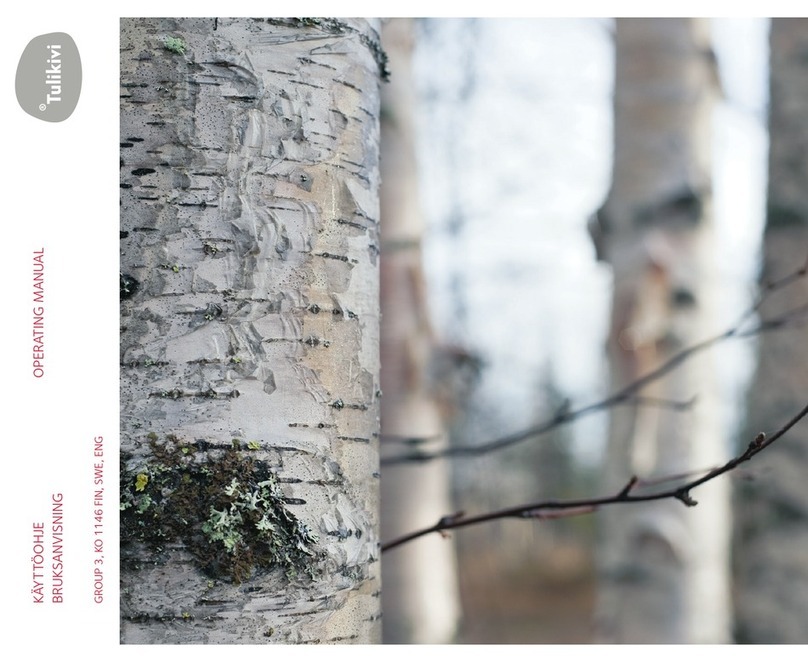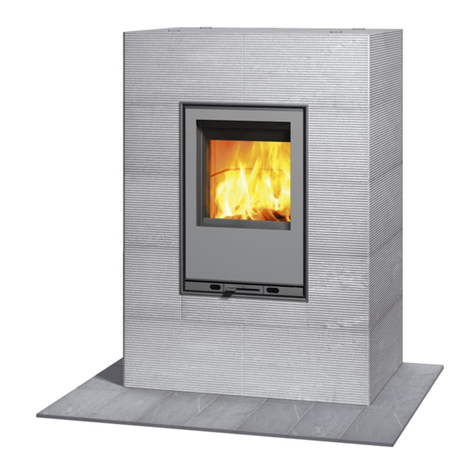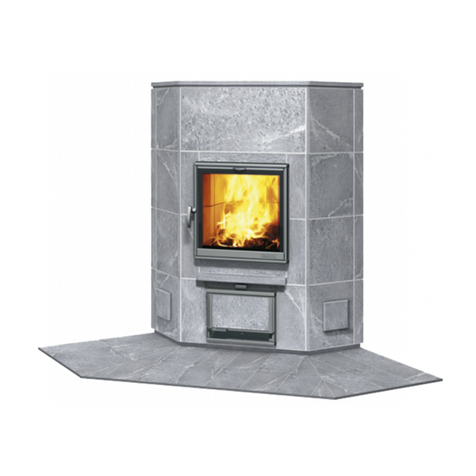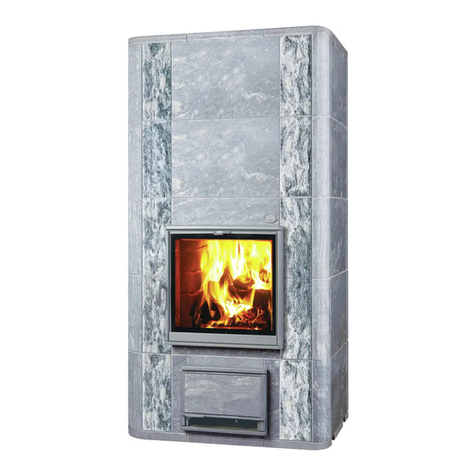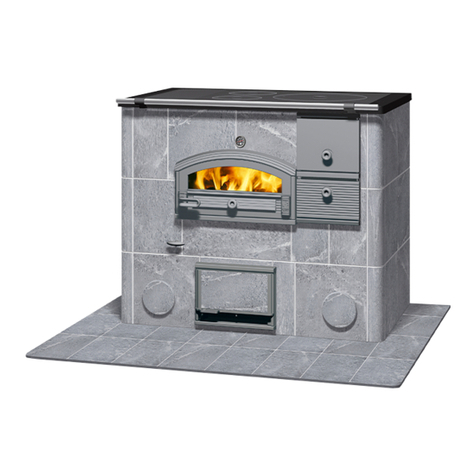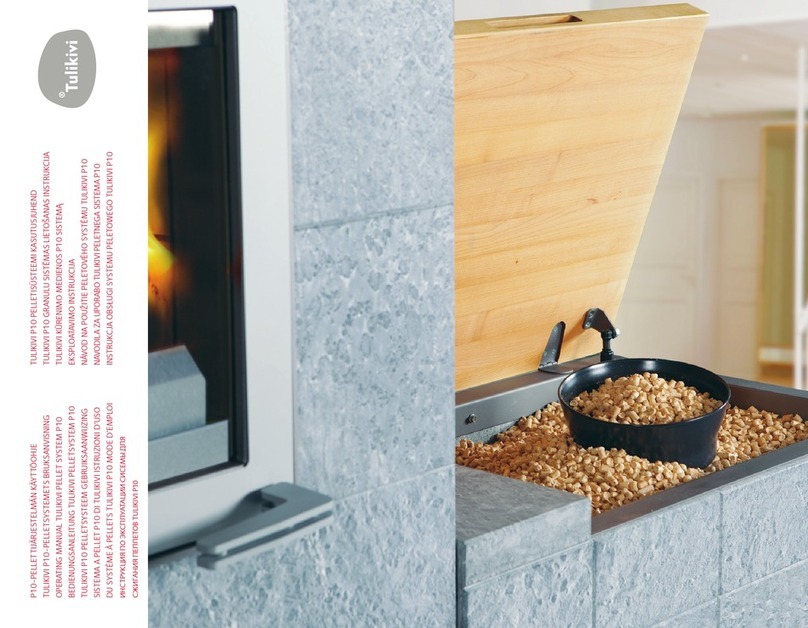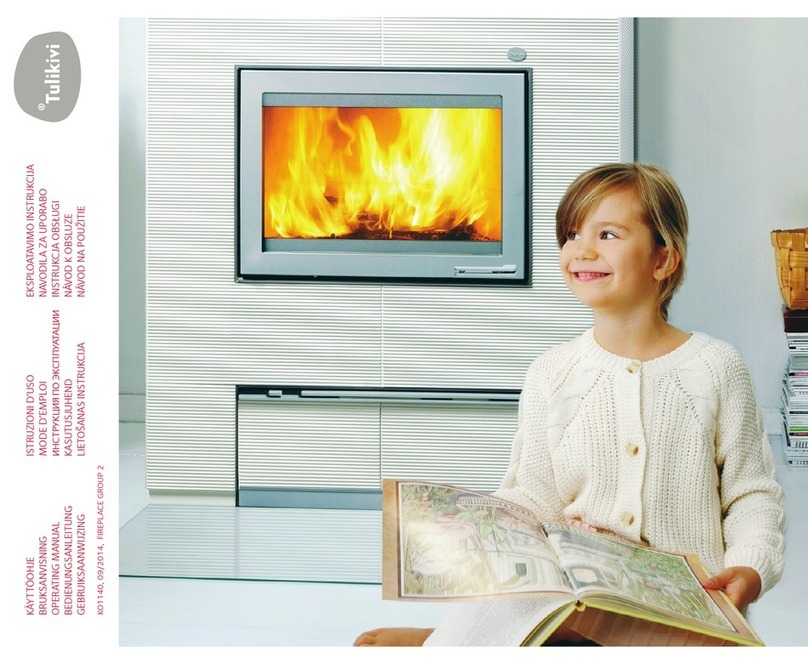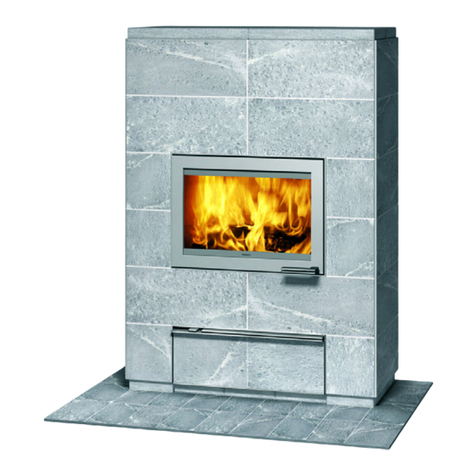
6
5.
12.
Nuohousluukut sijaitsevat tuhkalaatikon takana.
5.
9.
Siirrä hiilet reunoilta arinan päälle.
10.
Käännä ilmansäätö kiinni.
5.
11.
Sulje hormipelti.
Käännä ilmansäätö kiinni.
uunin paistolämpötilat on esitetty kuvassa 16. Lämpötilat perustuvat
käyttöohjeen mukaiseen lämmitykseen.
Leivinuunin pesän lämpötila on varsinaisen kaasupalon aikana yli
800°C astetta. Tämä lämpötila takaa, että leivinuuni palaa puhtaaksi
ja lämpenee hyvään paistolämpötilaan.
LEIVINUUNIN LÄMMITYKSESSÄ HUOMIOITAVAA
Kun uuni on kylmä (lämmitys korkeintaan kerran päivässä), leivinuu-
nissa poltetaan kolme noin 7 kg:n puupanosta. Mikäli uuni on valmiiksi
lämmin (kahdesti päivässä lämmitettäessä), riittää noin puolet puu-
määrästä. Varaa sytytykseen pilkkeitä (halkaisija 1 - 3 cm) niin, että ne
muodostavat ensimmäisestä panoksesta vajaan puolet. Lado suurem-
mat puut alle ja pienet pilkkeet päälle hieman ristikkäin. Sytytä tämän
jälkeen panos päältä käyttäen apuna paperia, tuohta tai sytytyspalaa
siten, että pienet pilkkeet syttyvät ensin.
Puiden lisäyksen voi tehdä, kun edellinen panos on palanut hiilloksel-
le. Ennen lisäystä vedä hiilet tulipesän reunoille niin, että arinalle jää
tyhjä tila, johon puut voidaan lisätä. Näin varmistat puhtaan palami-
sen. Polttopuuna voit käyttää pituudeltaan 33 - 50 cm klapeja, joiden
halkaisija on 5 - 10 cm.
Leivinuunissa leivinuunin luukun ilmanohjausaukot pidetään auki sytyt-
tämisen ja palamisen aikana. Keskimmäisen hiilenpolttoarinan luukun
ilmanohjausaukot avataan, kun ensimmäinen panos on kunnolla sytty-
nyt. Kun viimeinen panos on palanut hiillokselle, pudota hiilet tulipesän
takaosan kautta hiiliarinalle, jossa ne palavat loppuun luovuttaen vie-
lä lämpöä. Sulje samalla leivinuunin luukun ja hiilenpolttoarinan luukun
ilmanottoaukot ja avaa alimman tuhkaluukun ilma-aukot. Kun hiillos
on palanut loppuun hiilenpolttoarinalla, voit sulkea hiilenpolttoarinan
ilma-aukot ja hormipellin. Ole huolellinen kytevien hiilten kanssa, jotta
häkää ei pääse muodostumaan huonetilaan.
HAUDUTUSUUNIN KÄYTTÖÖNOTOSSA HUOMIOITAVAA
Haudutusuuni kannattaa pyyhkiä puhtaaksi ennen käyttöönottoa.
Haudutusuuni lämpiää takkauunin lämmityksellä, eikä haudutusuu-
nissa voi polttaa puita. Lämmitä takkauunia, jossa on haudutusuuni,
takkauunin lämmitysohjeen mukaisesti, mutta huomioi seuraava poik-
keus: Pidä haudutusuunin luukku auki tulisijan kuivatuksen ja sisään-
ajolämmitysten ajan.
HAUDUTUSUUNIN KÄYTÖSSÄ HUOMIOITAVAA
Huomaa, että hormipelti (mikäli asennettu) pitää jättää hieman raol-
leen kypsentämisen tai paistamisen ajaksi. Yläosan laattojen takana
takaseinässä on pieni höyrynpoistoreikä, jonka kautta ruoasta tai lei-
vonnaisista peräisin oleva vesihöyry poistuu savuhormiin. Kun käytät
haudutusuunia varsinkin pitempään paistamiseen ja korkeampaa läm-
pötilaa vaativien ruokien kypsentämiseen, tulisija kannattaa lämmittää
edellisenä päivänä. Näin saat haudutusuuniin tasaisemman lämmön.
Haudutusuuni lämpiää noin 210 – 230 asteen lämpötilaan. Kuumim-
millaan haudutusuuni on noin kolmen tunnin kuluttua lämmityksen
aloittamisesta. Edellisenä päivänä esilämmitetty haudutusuuni on yli
200 asteen lämpötilassa noin kolmen tunnin ajan. Tarkkaile arina–
lämpömittaria. Suosittelemme, että aloitat paistamisen/ruoanlaiton
lämmityksen jälkeen. Varsinkin ylhäältä hormiin liitetyissä tulisijoissa
haudutusuunin lämpötila on lämmityksen aikana epätasainen. Syty-
tyspellin puolella lämpötila voi olla jopa +50 oC korkeampi kuin toi-
sella puolella.
Säännöllinen huolto
Puhdista tulipesä tuhkasta ennen jokaista lämmityskertaa. Tarkista,
ettei tuhkalaatikko ole täynnä ja tyhjennä se tarvittaessa. Tuhkalaa-
tikon tyhjennyksen yhteydessä tuhkalaatikon alusta kannattaa puh-
distaa, ettei irtotuhkaa kasaudu laatikon alle. Puhdista myös luukun
alaosa.
Jos käytät imuria, on siihen ehdottomasti hankittava tuhkan imuroin-
tiin tarkoitettu lisävaruste. Turvallisuussyistä tee huoltotoimenpiteitä
vain, kun uuni ja tuhka ovat kunnolla jäähtyneitä.
LAATTAPINNAN PUHDISTUS
Puhdista laattapinta, kun tulisija on kylmä. Laatta on helppo puhdistaa
kostealla pyyhkeellä. Liikaa vedenkäyttöä on varottava, sillä sauma-
aine on huokoista ja saattaa kuivua läikikkääksi.
LUUKUN LASIN JA KEHYKSEN PUHDISTUS
Tulikivi-tulisijojen luukut on suunniteltu siten, että ilmavirtaus huuh-
telee lasia sisältäpäin pitäen sen kirkkaana. Jos lasipintaan kuitenkin
tarttuu nokea, kannattaa se puhdistaa heti, kun tulisija on jäähtynyt.
Tuhka on aina saatavilla oleva ja ekologinen puhdistusaine. Ota kostu-
tettuun talouspaperiin hieman hienoa tuhkaa tuhka-astiasta ja hankaa
